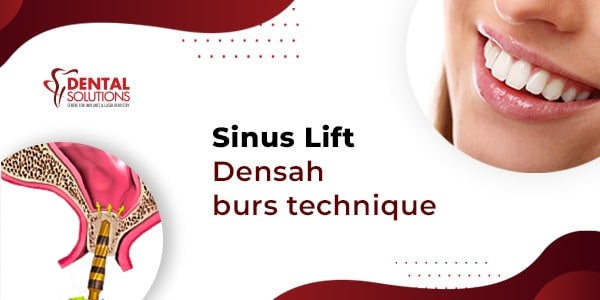Before and After

Sinus Lift – Densah burs technique
The Densah burs technique of sinus lift is used to improve the connection between implant posts and the jawbone. This procedure involves using a small, blunt instrument to make a hole in the bone and then filling it with bone graft material. This helps to provide a more secure foundation for dental implants.
With the advancement of implant dentistry, the most popular and predictable mode of replacement of missing teeth is dental implants. After placement of an implant, to achieve better integration of the implant with the surrounding bone there should be good quality and quantity of bone right around the surgical site, at least 2mm or more.
What Are Sinuses?
Sinuses are hollow cavities that are present within the skull, These help humidify and filter air. There are four types of sinuses amongst which Maxillary Sinuses which are located in our cheekbones just adjacent to our nasal bones on either side are the largest.
Need for Sinus lift – Densah burs technique?
There are certain physiological changes that are seen in patients who are devoid of teeth for a long duration of time, especially in the upper jaw i.e maxilla. These include vertical bone loss resulting in close proximation of maxillary sinus to the bone, hence diminishing the thickness of the bone which further limits the chances for implant placement.1
Key to success – Osseointegration!
Osseointegration is the connection between living bone and the titanium implant surface and is considered a prerequisite for implant loading. Whereas implant primary stability is one of the most important factors for successful osseointegration.2 There have been many techniques
tried in the past to increase the implant primary stability in low density bone. Although demonstrating a considerable amount of success, these techniques did come with drawbacks of their own.
Densah Burs Technique – Osseodensification
Osseodensification means making the bone more dense and strong enough to receive an implant. The process involves the use of special drills (Densah) run in a counter-clockwise direction at the surgical site. It is claimed that this causes expansion in the desired area, and increases the density of the bone nearby. Unlike traditional dental drilling techniques, osseodensification does not excavate bone tissue. Rather, bone tissue is simultaneously compacted and auto-grafted in the vicinity of the surgical site where later implant is eventually drilled in.
What is so unique about Densah burs technique ?
Densah burs are unique because of these features mentioned below:
Its Design – Densah® Burs are designed in a way such that its bone depositing surface is more, which precisely guides them through bone hence autografting bone instead of excavating.
The way it moves
- Counter-clockwise meaning densifying mode.
- Clockwise meaning cutting mode when required.
The bur is made to advance with vertical pressure inside the drilling site then give it some rest for pressure relief and again it is proceeded. The duration of the process is dictated by the bone density and the desired length of the implant to be placed.
Densah bur kit – a quick preview
Densah® Burs are designed to be used at drill speeds of 800-1500 rpm. They are marked with laser markings from 3-20 mm depth.
Kit includes a set of 12 burs.
Conclusion
Even though a modest number of research studies are available, current literature evidence points towards an overall increase in bone density in the drilling site. Primary implant stability is also increased through the use of this osseodensification drilling protocol using Densah burs because of faster osseointegration. Bone expansion in the desired site is successfully claimed to be attained using this technique which is claimed to contribute to having a success rate of over 90% and can now be successfully and predictably used to replace missing teeth in the oral cavity.
References
1. Aruna Wimalarathna. Indirect Sinus Lift: An Overview of Different Techniques. Biomed J Sci & Tech Res 33(4)- 2021. BJSTR. MS.ID.005447.
2. Padhye NM, Padhye AM, Bhatavadekar NB. Osseodensification––A systematic review and qualitative analysis of published literature. Journal of oral biology and craniofacial research. 2020 Jan 1;10(1):375-80.
